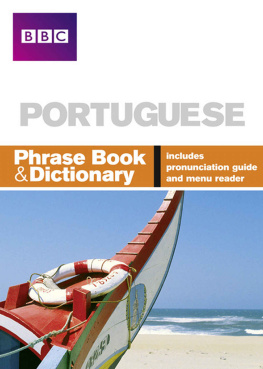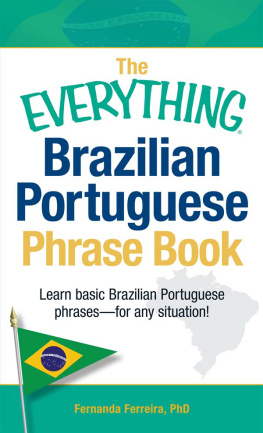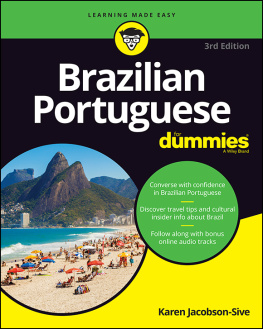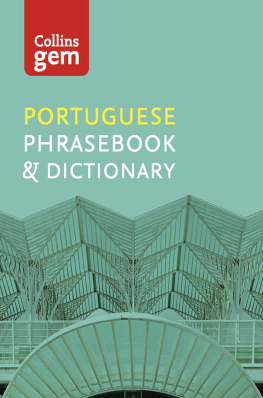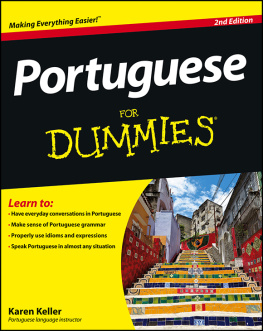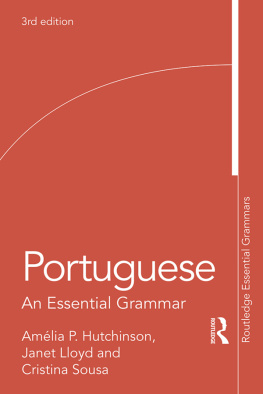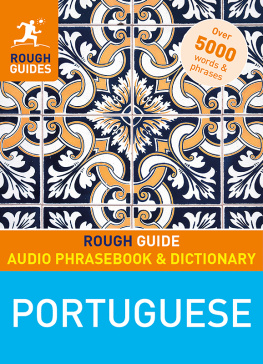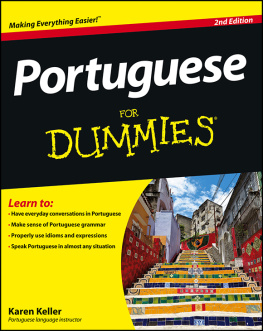OTHER PENGUIN PHRASE BOOKS DutchFrenchGermanGreekItalianRussianSpanishTurkish PORTUGUESE PHRASE BOOK THIRD EDITION JILL NORMAN ANTONIO DE FIGUEIREDO PENGUIN BOOKS PENGUIN BOOKS Published by the Penguin Group Penguin Books Ltd, 80 Strand, London WC2R 0RL, England Penguin Putnam Inc., 375 Hudson Street, New York, New York 10014, USA Penguin Books Australia Ltd, 250 Camberwell Road, Camberwell, Victoria 3124, Australia Penguin Books Canada Ltd, 10 Alcorn Avenue, Toronto, Ontario, Canada M4V 3B2 Penguin Books India (P) Ltd, 11 Community Centre, Panchsheel Park, New Delhi 110 017, India Penguin Books (NZ) Ltd, Cnr Rosedale and Airborne Roads, Albany, Auckland, New Zealand Penguin Books (South Africa) (Pty) Ltd, 24 Sturdee Avenue, Rosebank 2196, South Africa Penguin Books Ltd, Registered Offices: 80 Strand, London WC2R 0RL, England www.penguin.com First published 1971 Second edition 1979 Third edition 1988 Copyright Jill Norman and Antonio de Figueiredo, 1971, 1979, 1988 All rights reserved Except in the United States of America, this book is sold subject to the condition that it shall not, by way of trade or otherwise, be lent, re-sold, hired out, or otherwise circulated without the publishers prior consent in any form of binding or cover other than that in which it is published and without a similar condition including this condition being imposed on the subsequent purchaser ISBN: 978-0-14-193675-8
CONTENTS
INTRODUCTION
In this series of phrase books, only those words and phrases that might be called essential to a traveller have been included, but the definition of traveller has been made very wide, to include not only the business traveller and the holiday-maker, whether travelling alone, with a group or the family, but also the owner of a house, an apartment or a time-share. Each type of traveller has his or her own requirements, and for easy use the phrases are arranged in sections which deal with specific situations. Pronunciation is given for each phrase and for all words in the extensive vocabulary. An explanation of the system used for the pronunciation guide is to be found on . It is essential to read this section carefully before starting to use this book. Some of the Portuguese phrases are marked with an asterisk* these attempt to give an indication of the kind of reply you might get to your question, and of questions you may be asked in your turn.
For those who would like to know a little more about the Portuguese language, a brief survey of the main points of its grammar is provided at the end of the book (). We have tried to add new words and phrases to take into account recent social and technological developments. However, there is a tendency to use original English words; words such as stress, babysitter, jet lag, hovercraft and hydrofoil are still better known than their Portuguese equivalents. But you will always be rewarded for, and helped in, your efforts to speak Portuguese.
PRONUNCIATION
The pronunciation guide is intended for people with no knowledge of Portuguese. As far as possible the system is based on English pronunciation, but as Portuguese has an infinitely more complex sound structure, complete accuracy will sometimes be lost for the sake of simplicity.
However, the reader should be able to understand Portuguese pronunciation and to make himself understood if he reads this section carefully. Each word and phrase has a transcription into English symbols according to the rules set out below. VOWELS
| Pronounce: a as a in father symbol ah fbrica factory (fah-bree-ka) |
| as a in about or as u in put symbol a amigo friend (a-mee-goo) |
| e, as e in bet symbol eh serra mountain (seh-ra) |
| e, as ay in stay or as ey in they symbol ay a ai fazer to do (fa-zair) |
| e, i as e in open or as i in bit (occurs only in an unstressed syllable, and as a final letter it is almost silent) symbol e antes before (an-tesh) |
| i as i in machine symbol ee mil thousand (meel) |
| Before a, e, o or u in unstressed symbol y, ee frias holiday (fe-ree-ash) |
| syllables i resembles y in yes |
| o as o in olive symbol o bola ball (bo-la) |
| o, ou, , final oa as o in so, most symbol oh vo egg (oh-voo) |
| o as oo in boot (used in most unstressed syllables) symbol oo dormir to sleep (door-meer) |
| Before stressed a, e, i, o resembles w in wet symbol w Coimbra (kwee-bra) |
| u as u in rule or oo in boot symbol oo usar to use (oo-zar) |
| Before a, e, i, and after o the u sound resembles w in wet symbol w gua water (a-gwa) |
DIPHTHONGS
| Pronounce ai as ie in tie symbol i, y pai father (py) |
| au as ow in how symbol ow causa cause (kow-za) |
| oi,i, as oi in oil or oy in boy symbol oy lenois sheets (laysoysh) |
The other double vowels
ei, i, u do not really have special sounds. They are very close to the sounds of the separate parts as listed above, and the same symbols are used. e.g. comeis you eat (koo-may-eesh); cu sky (seh-oo).
NASALS These sounds should be made through the nose, but without pronouncing the n. Nasalization is shown in spelling by a tilde over the vowel, or by an m at the end of a word, or by m or n before a consonant.
| , am, an symbol a ma apple (ma-sa) |
| , em, en symbol ay e cento hundred (se-too) |
| im, in symbol ee cinco five (seen-koo) |
| , om, on symbol o bom good (bo) |
| um, un symbol oo um one (oo) |
| o symbol ow po bread (pow) |
| e, i symbol y me mother (my) |
| e symbol oy limes lemons (lee-moysh) |
CONSONANTS b, f, l, m, p, q, t, v are pronounced as in English, but note the following:
| c before a, o, u or a consonant is pronounced k symbol k casa house (kah-za) |
| c before e, i and are pronounced s symbol s certo certain (sair-too) |
| ch is pronounced sh as in ship symbol sh chave key (shahv) |
| d is softer than in English |
| g before a, o, u is pronounced g as in got symbol g garfo fork (gahr-foo) |
| gu in combination gue and gui the u is not pronounced; its purpose is to keep the |
Next page

